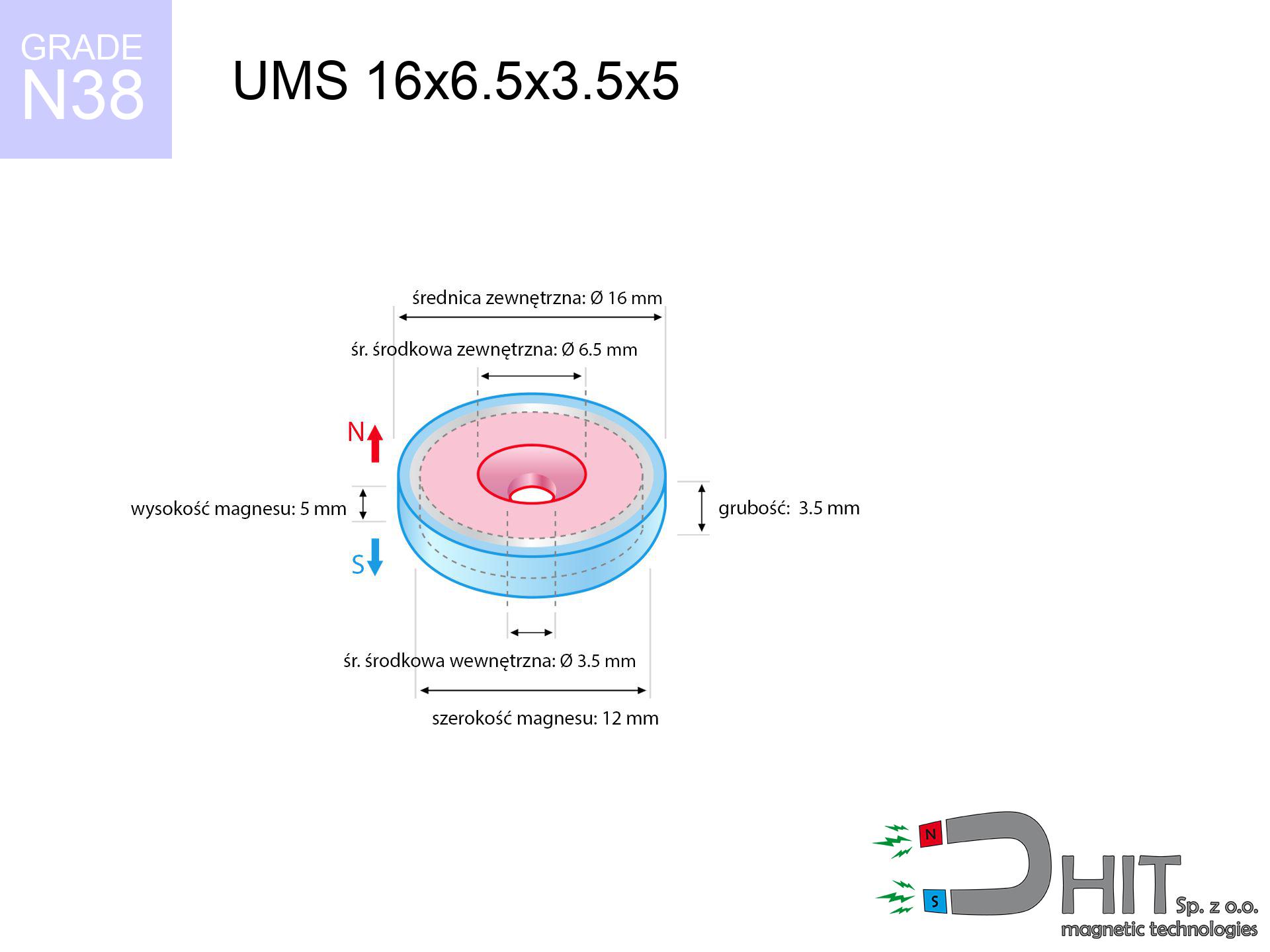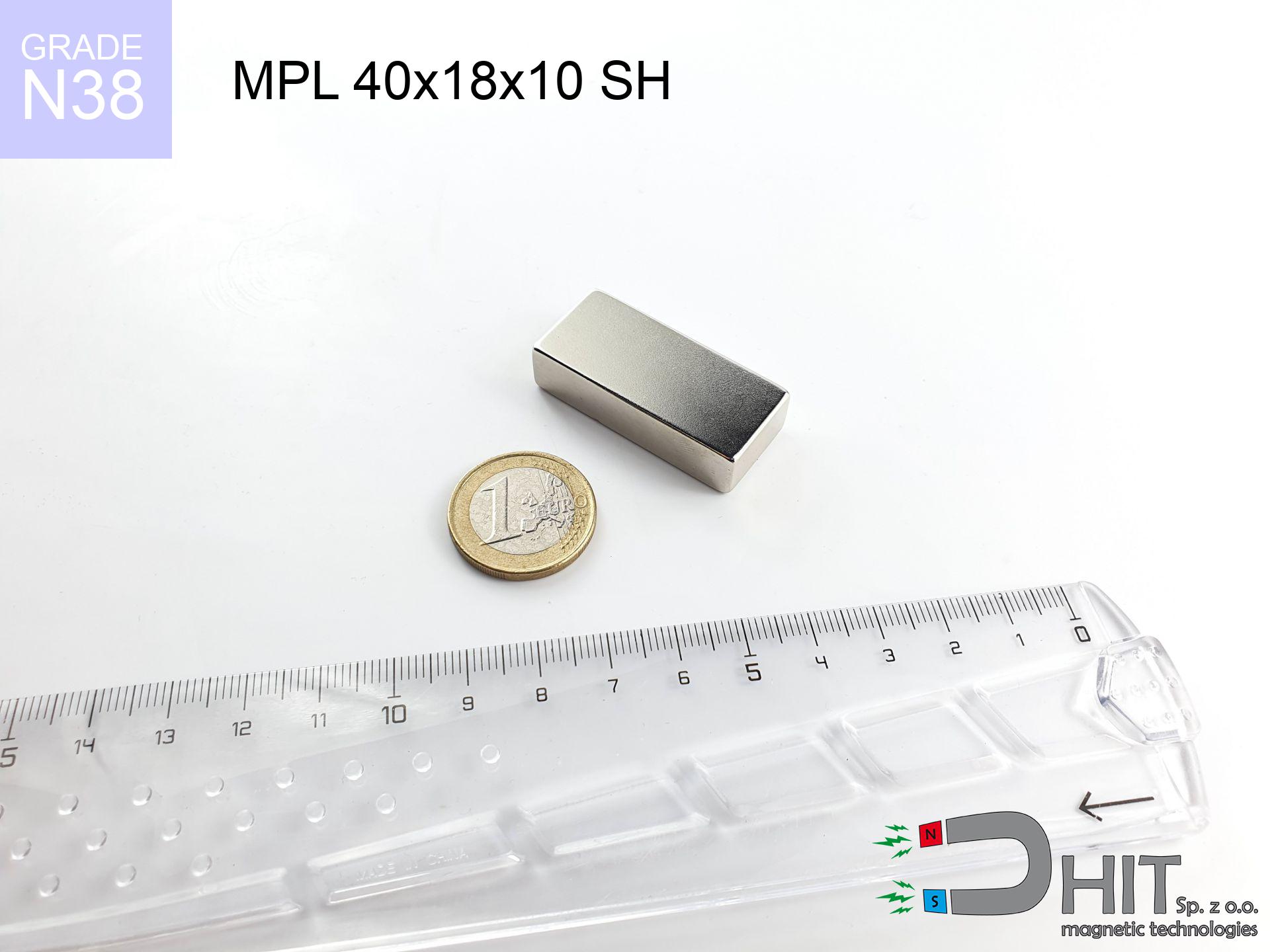UMS 16x6.5x3.5x5 / N38
conical magnetic holder
catalog number 220326
GTIN: 5906301814160
diameter Ø
16 mm [±0,1 mm]
cone dimension Ø
6.5x3.5 mm [±0,1 mm]
height
5 mm [±0,1 mm]
capacity ~
5.00 kg / 49.03 N
max. temperature
≤ 80 °C
3.35 PLN gross price (including VAT) / pcs +
2.72 PLN net price + 23% VAT / pcs
bulk discounts:
need more quantity?Don't know what to buy?
Call us tel: +48 22 499 98 98 or contact us through form on the contact page. You can check the power as well as the appearance of neodymium magnets in our magnetic mass calculator magnetic calculator
Orders placed by 2:00 PM will be shipped on the same business day.
Specification: conical magnetic holder 16x6.5x3.5x5 / N38
Magnetic properties of the material N38
Physical properties of sintered neodymium magnets Nd2Fe14B
Find suggested articles
Advantages and disadvantages of neodymium magnets NdFeB.
Apart from immense power, neodymium magnets have the following advantages:
- They do not lose their strength (of the magnet). After approximately 10 years, their strength decreases by only ~1% (theoretically),
- They are highly resistant to demagnetization by external magnetic field,
- In other words, thanks to the glossy nickel, gold, or silver finish, the element gains an aesthetic appearance,
- They have exceptionally high magnetic induction on the surface of the magnet,
- Thanks to their high temperature resistance, they can operate (depending on the form) even at temperatures up to 230°C and above...
- Thanks to the flexibility in shaping and the ability to adapt to specific requirements – neodymium magnets can be produced in a wide range of shapes and sizes, which amplifies their universality in usage.
- Significant importance in the industry of new technologies – are utilized in HDD drives, electric motors, medical apparatus or very modern machines.
Disadvantages of neodymium magnets:
- They can break as they are extremely fragile when subjected to a powerful impact. If the magnets are exposed to impacts, it is suggested using magnets in a metal holder. The steel housing in the form of a holder protects the magnet from impacts and simultaneously increases its overall strength,
- They lose power at high temperatures. Most neodymium magnets experience permanent loss of strength when heated above 80°C (depending on the shape and height). However, we also offer special magnets with high temperature resistance, up to 230°C,
- Magnets exposed to a humid environment can corrode. Therefore, when using them outdoors, we suggest using waterproof magnets made of rubber, plastic, or other moisture-resistant materials,
- The use of a cover - a magnetic holder is recommended due to the limited production capabilities of creating threads or complex shapes in the magnet
- Health risk to health from tiny fragments of magnets can be dangerous, in case of ingestion, which is particularly important in the aspect of protecting young children. Furthermore, miniscule components of these magnets can hinder the diagnostic process after entering the body.
Be Cautious with Neodymium Magnets
Neodymium magnets are among the strongest magnets on Earth. The astonishing force they generate between each other can surprise you.
Familiarize yourself with our information to correctly handle these magnets and avoid significant swellings to your body and prevent damage to the magnets.
You should keep neodymium magnets at a safe distance from the wallet, computer, and TV.
Strong fields generated by neodymium magnets can damage magnetic storage media such as floppy disks, credit cards, magnetic ID cards, cassette tapes, video tapes, or other similar devices. In addition, they can damage televisions, VCRs, computer monitors, and CRT displays. You should especially avoid placing neodymium magnets near electronic devices.
Do not bring neodymium magnets close to GPS and smartphones.
Neodymium magnets are a source of intense magnetic fields that cause interference with magnetometers and compasses used in navigation, as well as internal compasses of smartphones and GPS devices.
Dust and powder from neodymium magnets are highly flammable.
Do not attempt to drill into neodymium magnets. Mechanical processing is also not recommended. If the magnet is crushed into fine powder or dust, it becomes highly flammable.
Magnets made of neodymium are fragile as well as can easily crack as well as shatter.
Neodymium magnets are characterized by significant fragility. Neodymium magnets are made of metal and coated with a shiny nickel surface, but they are not as hard as steel. In the event of a collision between two magnets, there may be a scattering of fragments in different directions. Protecting your eyes is crucial in such a situation.
The magnet coating is made of nickel, so be cautious if you have an allergy.
Studies show a small percentage of people have allergies to certain metals, including nickel. An allergic reaction often manifests as skin redness and rash. If you have a nickel allergy, you can try wearing gloves or simply avoid direct contact with nickel-plated neodymium magnets.
Neodymium magnets can demagnetize at high temperatures.
Despite the general resilience of magnets, their ability to maintain their magnetic potency can be influenced by factors like the type of material used, the magnet's shape, and the intended purpose for which it is employed.
Keep neodymium magnets away from people with pacemakers.
In the case of neodymium magnets, there is a strong magnetic field. As a result, it interferes with the operation of a heart pacemaker. However, if the magnetic field does not affect the device, it can damage its components or deactivate the device when it is in a magnetic field.
Magnets are not toys, children should not play with them.
Neodymium magnets are not toys. You cannot allow them to become toys for children. In such a situation, surgery is necessary to remove them. In the worst case scenario, it can result in death.
Magnets will attract to each other, so remember not to allow them to pinch together without control or place your fingers in their path.
Magnets attract each other within a distance of several to about 10 cm from each other. Don't put your fingers in the path of magnet attraction, as a major injury may occur. Depending on how massive the neodymium magnets are, they can lead to a cut or alternatively a fracture.
To raise awareness of why neodymium magnets are so dangerous, see the article titled How dangerous are very strong neodymium magnets?.





![badge holder 33x13x4 [C311] / N38 badge holder 33x13x4 [C311] / N38](https://cdn3.dhit.pl/graphics/products/ui33x13x4-c311-vub.jpg)



